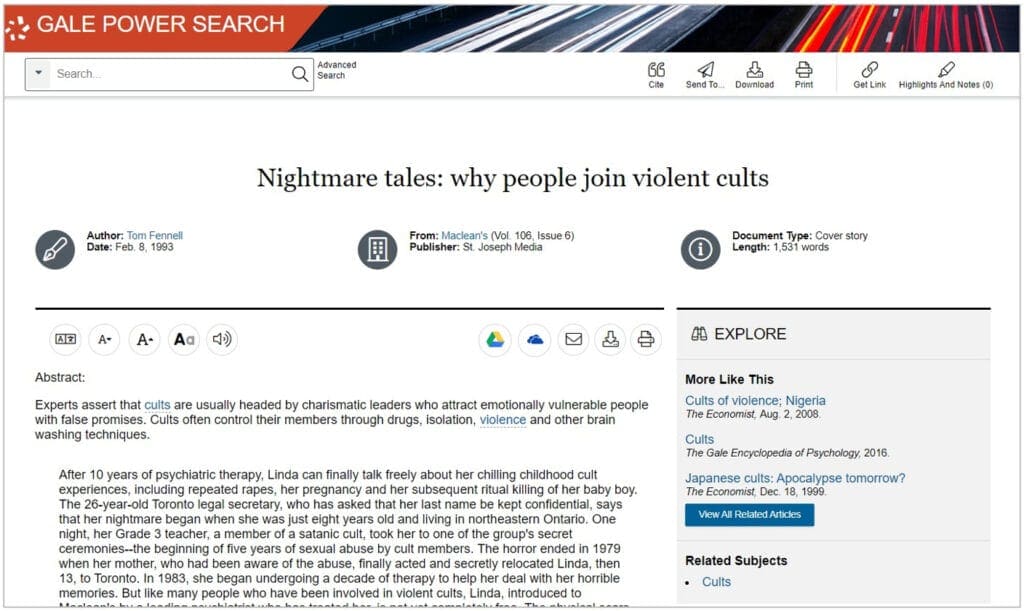|By Rais Asylnaz, Year 11 Student at Nazarbaev Intellectual School in Pavlodar|
Throughout the years, cults have captured the attention of many people. Whenever cults are discussed it’s impossible to avoid talking about the controversies surrounding them. These organisations have sparked interesting debate as to why people engage with and end up involved in cults. In this blog post, I will explore cults’ characteristics, the psychology of those involved, and the reasons behind their appeal.
What is Meant by the Term ‘Cult’?
First and foremost, let us define what is meant by the term cult. A cult usually refers to a destructive organisation, often with religious elements or characteristics. According to this article by Tom Fennell, that I found in Gale Academic OneFile, cults are usually headed by charismatic leaders who attract emotionally vulnerable people with false promises. Members of the cult are expected to exhibit absolute devotion to the leader and complete trust in their fellow members.

Fennell, Tom. “Nightmare tales: why people join violent cults.” Maclean’s, vol. 106, no. 6, 8 Feb. 1993, pp. 26+. Gale In Context: High School, https://link.gale.com/apps/doc/A13430965/GPS?u=nispavlo&sid=bookmark-GPS&xid=1487192d
How Do Cults Acquire Members?
Now, let us explore the reasons as to why people become drawn into cults. It is argued that many people who end up in this sort of community seek validation, more meaning in their lives, and perhaps an escape from loneliness. They are ready to put everything on the line if it means they feel some sort of hope and inclusion. Individuals can also be drawn to cults after a difficult life experience that was emotionally draining. According to this article by Tom Fennell, found in Gale Academic OneFile, both violent and nonviolent cults often prey on people who are confused or disturbed. Mentally unstable people are also one of the main targets of cults because of how easily they can be manipulated. It is also important to pinpoint that not all cult members joined such organisations out of their own choice; some cults resort to kidnapping when they need new members.
How Do Cults Retain Members?
There are many tactics used to convince people to stay in such unhealthy and problematic environments, but some are particularly common, including:
- Group thinking and erasure of self of identity: Members are made to conform to the cult’s beliefs and ideals; personal opinions and individuality are not supported and, in some cases, even punished. As a part of this, some cults have required members to wear the same types of clothing, helping to develop group mentality more quickly and thoroughly.
- Isolation: Cults try to cut off their members from the outside world and its influence as much as possible, thus they will not know that what is being done to them is abnormal. However, in order to maintain the illusion of care, some cults allow the members to contact their families occasionally, although the exchange is strictly monitored.
- Control: Every little thing in the members’ lives is controlled. Starting from their day-to-day schedule to the things that they are allowed to talk about.
Over the years, thousands of cults have operated, and undoubtedly some are still active today. The most infamous ones that are even studied at schools are Aleph, more well known as Aum Shinrikyo, and The Peoples Temple.
Aleph
In 1987, Shoko Asahara founded the ‘Aum Shinrikyo’ cult in Japan. The cult was centred around Buddhism and borrowed many ideas from its teachings. Asahara claimed himself to be Christ, the Buddha, and the embodiment of all human knowledge in one. This organisation quickly became popular, and the number of its adherents was constantly growing. According to this article by Erica Simons that I found in Gale Academic OneFile, from 1992 to 1995, Aum Shinrikyo membership increased from approximately 10,000 to 50,000 worldwide.
‘Aum Shinriky’ also gained fame abroad, and centres were opened in many big cities, such as New York. The Japanese police began arresting members of the sect in March 1995. Having decided to distract the attention of the police, members of the Aum Shinrikyo cult carried out a terroristic attack on the Tokyo subway. According to this article by Dereck Daschke, found in Gale Academic OneFile, 13 people were killed, and dozens were seriously injured in that incident. The leaders of the sect were arrested, but were only executed in 2018. It turned out that the activities of the cult included damaging the mental and physical health of its members.

“THE AUM SHINRIKYO CULT RELEASED SARIN IN A TOKYO SUBWAY ON MARCH 20, 1995. TWLEVE PEOPLE WERE”…” History Behind the Headlines: The Origins of Conflicts Worldwide, edited by Sonia G. Benson, et al., vol. 5, Gale, 2002. Gale In Context: World History, https://link.gale.com/apps/doc/PC3410687420/WHIC?u=nispavlo&sid=bookmark-WHIC&xid=c97d34b8
Peoples Temple
The ‘Peoples Temple’ organisation was established in 1955. It was based on religious teachings, although its founder Jim Jones was a communist. In his speeches, Jones compared Karl Marx’s ideas with Christ’s teachings, but at the same time actively criticised the Bible.

In the early days, the Peoples Temple became known for miraculous ‘healings’ of sick people and provided food and shelter to the needy. However, in the early 1970s, relatives of members of the sect brought several lawsuits against the cult. It was alleged that the organisation forcibly detained its members, took away money, and severely punished them for wrongdoings. After an incident involving U.S. Congressman L. Ryan, Jones ordered all the members of the Peoples Temple to drink poison. According to this article by Allen Pusey, found in Gale Academic OneFile, 918 people died in the mass suicide event, including 304 minors.

Is It Possible to Leave a Cult?
Since cults manipulate members’ minds and emotions, leaving one can be quite difficult – but not impossible. There are countless stories of people becoming aware of their indoctrination and oppression, and successfully escaping such communities. Often cult escapists need to be provided with special support, and are required to undergo therapy to help them transition back into society. Unfortunately, there have also been cases of people returning to cults after leaving them. Even if only a fraction of people do that, it still shows how effective the psychological manipulation inherent within a cult can be.
Educating Ourselves About the Dangers of Cults
Understanding cult dynamics and the reasons why people feel attraction towards them is crucial since the world of cults is complicated and terrifying. We can better protect ourselves and our loved ones against them by detecting signs of manipulation and understanding the psychological dynamics at work. In order to protect people from the dangerous effects of cult involvement we, as a society, should better educate ourselves about the dangers and horrors that many of those involved have had to face in the past.
Below are previous winning entries in the Nazarbayev Intellectual Schools essay writing competition:
- Researching the Impact of the New Silk Road on Kazakhstan
- How Important Was the Role of Women During WWII to the Victory of the Allied Powers?
If you’re interested in the existence of cults or dark psychology, you may like these blog posts about historic crimes and criminals:
- Are We Obsessed with Serial Killers?
- Using Gale Historical Newspapers to Explore the Representation of Coastal Wreckers
- The Murder of Empress Myeongseong of Korea
- ‘A Genteel Murderess’ – Christiana Edmunds and the Chocolate Box Poisoning
- ‘The compartment was much bespattered with blood’: the Brighton Railway Murder
- Gangster’s Paradise: Exploring British Media Coverage of American Organised Crime
- The Whitechapel Murders: exploring Jack the Ripper’s victims in the Crime, Punishment, and Popular Culture archive
Blog post cover image citation: A montage of images and articles included in this blog post.

